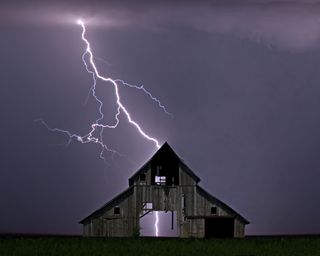How to Survive a Lightning Strike

There's a club open to people from all around the world, but you wouldn't want to join: The club is exclusively for people who've survived a lightning strike.
Lightning strikes kill about 24,000 people worldwide each year, and about 240,000 people are injured by lightning and survive.
But even decades after being hit by lightning, survivors can continue to experience devastating long-term effects. Because a lightning strike zone can carry thousands of volts of electricity per square foot, severe nerve damage is common among survivors, who often report cognitive problems like memory loss, an inability to concentrate and personality changes. [Electric Earth: Stunning Images of Lightning]
"A lot of your routine — where did you put your keys, how did you file this, the multitasking stuff — pieces are missing out of it," Dr. Mary Ann Cooper, director of the Lightning Injury Research Program at the University of Illinois at Chicago, told NBC News in a 2009 interview.
"Their friends don't come around anymore. [They] don't understand jokes; they're socially inappropriate. All of those filters are kind of gone," Cooper said.
Russ Chapman was walking across a parking lot in 1999 in Littleton, Colo., when lightning struck nearby, knocking him to the pavement. Since then, Chapman has been fired from jobs because he forgot to go to work, he often fails to eat and he suffers from health problems, including severe headaches, sleep problems and epilepsy.
"I know for a fact that people think I'm really weird," Chapman told NBC News.
Sign up for the Live Science daily newsletter now
Get the world’s most fascinating discoveries delivered straight to your inbox.
Survivors of lightning strikes often turn to Lightning Strike and Electrical Shock Survivors International, a group that provides information and support to victims and their families.
How to survive a lightning strike
The best way to survive, of course, is to avoid a lightning strike. The Federal Emergency Management Agency (FEMA) recommends people follow the 30/30 rule: If, after seeing lightning, you can't count to 30 before hearing thunder, get inside a building immediately (because the lightning storm is close). And don't go outside until 30 minutes after the last clap of thunder.
Sheds, dugouts, bus shelters and other structures don't offer real protection and may actually be targets for a lightning strike. Instead, find a substantial building with wiring and plumbing that will direct an electrical charge away from occupants.
It's safer to be in a vehicle than outdoors, provided it's a hardtop vehicle with the windows rolled up and not a convertible, according to FEMA. The metal frame of a vehicle will provide some protection (as long as passengers aren't touching any metal parts).
Remember that rubber tires and rubber-soled shoes provide virtually no protection from lightning. In fact, many victims of lightning strikes are farmers in open fields riding tractors with rubber tires.
If you're caught outdoors in a forest during a lightning storm, seek shelter in a low area under a dense growth of small trees. Avoid tall trees, since lightning tends to strike the tallest object in an area.
If you're in an open area, go to a low area, like a valley or a ravine (but be alert for flash floods). If you're in a boat in open water, get to land as quickly as possible.
And if you feel your hair stand on end, that means lightning is about to strike. As a last resort, immediately squat down on the balls of your feet, cover your ears with your hands (to minimize hearing loss) and put your head between your knees.
Do not lie flat on the ground — it's best to minimize your contact with the ground, since an electrical charge will travel across the ground.
If a person is struck by lightning, render assistance immediately — victims do not carry an electrical charge and cannot shock or hurt anyone.
Lightning by the numbers
A typical lightning flash contains about 300 million volts of electricity, or enough power to light a 100-watt compact fluorescent bulb for a year, according to the National Weather Service.
In the United States, lightning strikes kill about 100 people each year and injure about 1,000, according to the National Oceanic and Atmospheric Administration (NOAA).
FEMA estimates that your chances of being struck by lightning are now about 1 in 600,000. Over the past 100 years, the rate at which people are struck has dropped substantially, as fewer people now work outdoors on farms or ranches.
Florida experiences significantly more lightning strikes, deaths and injuries than any other state; NOAA recorded an average of 1.4 million lightning flashes per year in Florida.
The New England region typically receives relatively few lightning strikes, and California, despite its size, receives just 85,000 lightning strikes in an average year, largely due to its mild coastal weather.
And no other region of the world sees more lightning than central Africa: One small African town — the tiny village of Kifuka in the Democratic Republic of the Congo — is hit by lightning about 158 times each year.
Follow Marc Lallanilla on Twitter and Google+. Follow us @livescience, Facebook & Google+. Original article on LiveScience.com.

Most Popular

